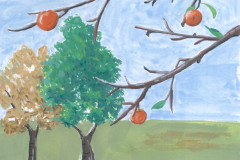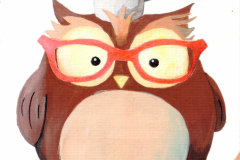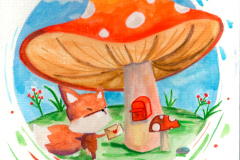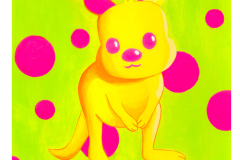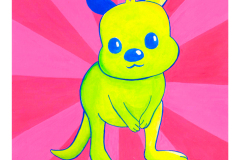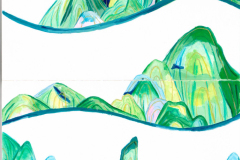Introduction
Impressionist landscape painting focuses on portraying natural scenes with emphasis on the effects of light and movement. The Impressionist style developed in 19th-century France, breaking away from traditional techniques. It embraces visible brushstrokes and a vibrant use of color to show scenes as they appear momentarily to the eye. Using gouache, an opaque water-based medium, can enhance this effect due to its quick coverage and ability to render bright colors.
Mastering your Impressionist landscape illustration involves understanding both the impressionist style and gouache painting techniques. This article guides you through these concepts with practical insights. You will learn how to paint outdoors “en plein air,” mix colors effectively, and use brush strokes that convey the feeling of a fleeting moment in nature. Are you ready to refine your skills and bring your landscapes to life with gouache?
Understanding Impressionism in Landscape Art
Impressionism changed how artists approached landscape painting. Instead of focusing on fine details and smooth surfaces, Impressionists aimed to capture natural light and movement as they saw them. They used visible brush strokes to bring energy to their scenes.
They often painted outdoors, or en plein air, to capture the changing qualities of light throughout the day. This approach helped them portray fleeting moments rather than fixed, idealized views.
This style broke from traditional painting, which prioritized realism and neat finishes. Impressionists wanted to show how light and atmosphere affected the landscape. Their paintings look alive with motion and light because of this focus.
What moment in nature around you might reveal natural light and motion that you haven’t tried to capture yet?
Key Features of Impressionism
Impressionists used short, broken brush strokes that often went in different directions. These strokes didn’t blend completely, creating dynamic, vibrant textures in their paintings. You can see color shifts that make the work sparkle with movement.
They preferred bright, unmixed colors instead of muted tones. This choice captured how sunlight alters the colors in nature. Instead of focusing on every small detail, they painted the overall visual impression of a scene.
Natural light’s constant change during the day played a key role in their work. Many painted the same scene multiple times at different hours to show these variations.
Historical Context and Impact on Landscape Painting
Impressionism began in 19th-century France as a challenge to the strict rules of academic art. Traditional painting demanded posed subjects, careful detail, and polished surfaces. Impressionists rejected these limits to focus on everyday life and natural settings.
This movement helped shift art toward modern styles by emphasizing what people actually perceive at a glance. By capturing light and immediacy, Impressionism paved the way for new ideas about color and form.
Today, you can trace many modern landscape techniques back to this moment when artists started trusting their eyes rather than following old rules.
Introduction to Gouache as a Painting Medium
Gouache is a type of paint made from pigment, water, and a binding agent, usually gum arabic. It stands out for its strong opacity, which means it covers surfaces well, even over dark colors. This property makes it different from watercolor, which is more transparent. Both gouache and watercolor use similar ingredients, but gouache contains more pigment and chalk to add weight and thickness.
Gouache dries quickly and leaves a matte finish that does not reflect much light. This matte surface brings out the vibrancy of colors without glare. Artists often choose gouache for commercial work like illustrations, posters, and animation because it works well with clear lines and bright colors.
When it comes to landscape illustration, gouache fits perfectly. It can capture the changing light and mood outdoors, allowing you to create layers and textures quickly. Its ability to be reactivated with water also lets you adjust your painting even after it seems dry.
Gouache Composition and Characteristics
Gouache consists mainly of pigment, water, gum arabic, and white chalk or an inert filler. The chalk gives gouache its characteristic heaviness and opacity. This means you can paint over mistakes or previous layers without losing brightness or texture.
It dries faster than watercolor and leaves a flat, non-glossy surface. Unlike watercolor, which can soak into paper fibers, gouache sits on the surface, maintaining a rich, solid color. This makes your colors look more vivid and less washed out once dry.
You can use gouache on paper, board, canvas, and wood. Because of its opaque nature, it reflects light differently, creating a soft but clear image. Try painting a green meadow under a bright sky to see how gouache holds color intensity without shine or glare.
Advantages of Gouache for Landscape Painting
Speed matters when you paint outdoors. Gouache dries fast, so you can apply new layers without waiting long. This works well for Impressionist techniques, where rapid changes in light and atmosphere must be captured quickly.
Its opacity lets you paint light over dark areas and add highlights with ease. You can build texture by layering thick strokes or apply paint directly with bold brush marks. This flexibility helps you show movement in trees, rippling water, or shifting clouds.
Imagine capturing the bright glow of morning sunlight on a hilltop. Gouache lets you work quickly to portray these fleeting moments. You can adjust brightness or shadow without losing previous details. This control makes your landscapes more dynamic and true to nature’s constant changes.
Preparing for Your Impressionist Gouache Landscape
Setting up for an Impressionist gouache landscape begins with thoughtful preparation. Your selection of materials will affect how easily you capture light and movement. Choose vibrant gouache colors that dry quickly and allow layering without muddiness. Prepare your palette by arranging colors in a way that encourages mixing bright hues directly on your palette or paper.
Find a location where natural light changes rapidly, such as a riverside at dawn or a park during late afternoon. These moments offer shifts in color temperature and shadow that define Impressionist work. Plan your composition by observing how light plays across your scene. Focus on shapes formed by light and shadow rather than details. A loose, open layout helps capture the fleeting quality of the moment.
Before painting, sketch lightly with pencil or watercolor pencil. Outline major elements and pathways of light to keep your work dynamic. Preparing this structure guides your brushwork and color choices, helping you respond quickly to changing conditions during your outdoor session.
Choosing Materials and Tools
Select gouache paints with high pigment concentration for brightness. Tubes or pans both work, but tubes offer easier mixing flexibility outdoors. Bring a variety of brushes, including flat and round shapes. Choose brushes with firm, springy bristles that hold paint well and allow expressive, bold strokes. Synthetic brushes often perform well with gouache.
Use heavyweight paper or illustration board that can handle wet layers without buckling. A cold-pressed surface helps create interesting textures. Consider a portable easel to keep your work steady and at a comfortable angle outdoors. For mixing, a simple white plastic palette or ceramic plate makes color assessment clear. Carry a water container and a rag for quick brush cleaning and paint adjustments.
Selecting and Preparing Your Scene
Choose a location where light creates strong contrasts and vibrant colors. Seek areas with trees, water, or architecture that catch the sun in interesting ways. Early morning or late afternoon light gives you warmer colors and dramatic shadows but changes quickly. Try to arrive early or stay late to observe how the scene shifts.
Start with a quick, light sketch to capture composition and key light areas. Focus on where the sunlight hits and where colors shift from warm to cool. Avoid drawing details at this stage. Use your sketch to plan where your brightest highlights and darkest shadows will go. This preparation will keep your painting loose but purposeful, helping you respond to nature’s movements as you layer gouache colors.
Mixing and Using Colors for Impressionist Effects
Impressionist landscape painting calls for a bright, lively color palette. Gouache is ideal for this because it offers strong, flat colors with a matte finish. To recreate this effect, focus on mixing colors that pop without losing their brightness. Use color theory to guide you, especially complementary colors like blue and orange or red and green. These pairs create contrast that suggests natural light and energy without black or dull tones.
Learn to balance warm and cool colors to show the temperature of different landscape parts. For example, use warm yellows and reds to highlight sunny areas, and cool blues and purples for shaded spots. You should try using unmixed, pure colors side by side along with carefully mixed hues. This creates a shimmering, vibrant surface that catches the eye just like classic Impressionist paintings.
Building a Vibrant Color Palette
Start with primary colors—red, blue, and yellow. These are your base for mixing most landscape shades. Pick secondary colors like green, orange, and purple from your palette, but keep the mixing limited. Mixing many colors tends to dull intensity, so rely on pure, unmixed pigments as much as possible. You want your palette to stay bright and alive.
Adding white is useful because gouache is opaque, but adding too much white can lower color intensity. Use white mostly to lighten tones for highlights, while keeping other colors pure for shadows and midtones. Experiment with different amounts of white to find the right balance between opacity and brightness in your landscape work.
Applying Color in Layers and Contrasts
Building your painting in layers helps create depth without heavy details. Start with flat areas of color and add more layers to suggest texture. Use color contrasts to define light and shadow instead of long shading strokes. For example, place a warm yellow next to a cool violet to indicate sunlight and shade.
Brushstrokes affect how color vibrates on your paper. Try short, broken strokes with unmixed colors touching each other. This can make your landscape feel alive with movement and flickering light. Experiment with stroke direction and pressure to see how color interaction changes the mood of your scene.
Brushwork Techniques to Capture Movement and Light
Impressionist brushwork with gouache focuses on creating lively surfaces full of light and motion. Instead of smooth spreading, use varied strokes to suggest how light shifts across a landscape. You achieve this by placing paint in broken patches rather than blending it continuously.
Apply colors in small touches or dabs to keep the paint’s vibrancy. This broken color method lets the eye mix colors from a distance, which keeps your painting bright and fresh. Changing the direction and length of brush strokes adds rhythm and flow, hinting at movement in grass, water, or clouds.
Think about how a swift sideways stroke can mimic wind or how dots of sunlight flicker through leaves. Your brushwork should catch not just forms but the energy behind them. What happens when you switch between thick and thin strokes or alter your brush angle? Exploring these variations gives your landscapes a sense of time passing and light changing.
Using Short and Broken Brush Strokes
Short, broken brush strokes create a flickering effect similar to how sunlight hits surfaces in nature. Paint small strokes side by side or in dabs without blending gradients. This technique avoids dullness and keeps your colors vivid.
Try placing contrasting colors close together—like yellow and blue in leaves—to suggest dappled light. Small, separate strokes help you show how light dances across uneven terrain or rippling water. The eye blends the colors, producing a dynamic, lively scene.
Keeping strokes short also prevents muddy areas where colors lose their brightness. How do your paintings change when you stop using smooth transitions and instead work with broken patches of color? Experiment with this to make your landscapes vibrant and full of life.
Expressing Movement with Brush Dynamics
You can simulate movement in landscapes by varying the direction, speed, and pressure of your brushstrokes. Fast, sweeping strokes imitate strong wind. Gentle, wavy lines suggest flowing water. Quick, twisting marks show leaves rustling in the breeze.
Mixing brush sizes helps add texture. Use larger brushes for broad motion like clouds or fields. Smaller brushes capture flickers of light or fine branches swaying. Apply different pressure; heavier strokes create weight, while lighter touches show airiness.
Think of your brush as a tool for rhythm. How does changing the speed of your stroke affect the feeling of movement? Using these dynamic motions alongside broken colors makes your gouache landscapes active and expressive.
Painting Outdoors to Capture Transient Light
Painting en plein air allows you to observe the true qualities of natural light and atmosphere with gouache. This approach helps capture subtle color shifts and fleeting shadows that studio work often misses. Working outside challenges you to respond quickly before light conditions change.
Gouache dries fast, which suits rapid adjustments but also means you must plan strokes carefully. You may face wind, insects, or sudden weather shifts, yet these hurdles push you to simplify and prioritize what to emphasize. Instead of exact details, aim to record the overall feeling of the scene at that moment.
How do you decide which elements to focus on as the sun moves or clouds pass? Keeping your palette limited and using loose strokes helps adapt your work on the spot. Painting outdoors with gouache trains your eye to see light interactions clearly and react with confidence to nature’s quick changes.
Benefits of Painting On Location
Direct observation on site brings fresh accuracy to your colors and light effects. You notice subtle pigments, like the glow of green over water or warm undertones in shadow areas. These insights enrich your gouache work beyond what photos allow.
The changing weather affects how you interpret the landscape. A cloud passing over bright sun might make you switch from warm tones to cooler ones in minutes. Experiencing these shifts firsthand encourages flexible painting choices.
Have you ever felt how the wind can shape a tree or how fog blurs outlines? Recording these moments strengthens your ability to portray nature’s movement and mood authentically. This immersion deepens the realism and life in your gouache landscapes.
Tips for Managing Outdoor Painting Sessions
Prepare for different weather by bringing a portable easel, umbrella, and lightweight supplies. Choose a sketch or photo reference beforehand but remain willing to change your plan as light evolves.
Set up quickly and keep your palette simple. Focus on broad shapes and color temperatures instead of fine details. Quick mixing and layering help capture light shifts efficiently.
When time feels limited, ask yourself which mood or moment matters most. Forget perfection. Prioritize feeling over precision to reflect the atmosphere. Do you notice how a scene’s energy changes in a few minutes? Let that guide your brush.
Layering and Texture in Gouache Landscape Illustration
Building layers in gouache gives your landscapes depth and character. Apply paint in stages, letting each layer partially dry before adding the next. This technique helps you adjust colors while keeping layers clear and vibrant. Avoid mixing too many wet layers at once; it can cause colors to muddy. Instead, allow drying time to preserve brightness and contrast.
Think about how different parts of your scene have unique textures. Use layering to bring out this variety. Thicker paint suggests rough areas like tree bark, while thinner washes capture softer elements like distant hills. Do you notice how varied layering can create a sense of space and detail in your work?
Using texture in your gouache painting enhances the impressionist style. Texture tricks the eye into perceiving movement and light shifts. Adding roughness or smoothness with layers keeps your landscape lively and engaging without overwhelming the scene.
Effective Gouache Layering Techniques
Apply your gouache in thin layers and wait until they are partly dry before adding the next. This approach gives you control over color intensity and lets each layer shine through. The layered colors work together to create a glowing effect, making your landscape seem alive.
Keep layers separate to avoid blending into a flat color. Each visible layer builds texture and complexity. Decide where you want sharp edges or soft transitions, and play with drying times to achieve that. How can you balance layering speed with drying time for the effect you want?
Using Textural Effects to Enhance Visual Interest
Try dry brushing to create rough textures like grass or tree bark. Use a nearly dry brush with little paint to drag over your surface, leaving streaks and gaps. Scumbling—applying a light, broken layer of color—can add softness to clouds or water reflections.
Lift paint by blotting with a damp cloth or sponge while the paint is still wet. This technique creates highlights and texture that suggest light breaking through leaves or shimmering on water. Texture not only adds detail but also helps capture the natural variations you see in the landscape.
What textures in your scene can you suggest with gouache’s unique qualities? Experimenting with these effects will bring your impressionist landscapes closer to life.
Common Challenges and How to Overcome Them
Painting Impressionist landscapes with gouache brings unique challenges. Matching colors to your scene can be tricky because natural light changes constantly. You might find the colors don’t look the same on your palette and on the paper. Testing your colors in small patches before applying them widely helps you avoid surprises.
Another difficulty is that gouache often dries lighter or darker than expected. This shift can change the mood or balance of your work. Try mixing colors with this drying change in mind. Keep notes of your color mixes so you can adjust easily during your painting sessions.
Keeping your layers fresh and vibrant also takes care. Overworking an area or mixing paint too much on your brush can dull your colors. To prevent this, use clean brushes often and load them with fresh paint. Consider breaking your work into smaller sessions to maintain brightness and energy in your strokes.
Managing Color Changes After Drying
Colors in gouache rarely stay the same after drying. You might apply a bright blue that looks dull once dry. To handle this, test each new mix on scrap paper. Observe how the color shifts and decide if you want to adjust the mix before painting your main piece.
Mix slightly stronger or deeper tones if your samples dry lighter than you want. Keep your mixes consistent by writing down each color formula. This practice helps you anticipate changes quickly without wasting paint or time.
Ask yourself, how do the drying shifts affect the atmosphere you want? Does the lighter or darker tone fit the natural light you’re capturing? Adjust your mixes to support your vision instead of fighting the medium.
Keeping Paint Layers Fresh and Vibrant
Vibrancy in gouache comes from handling paint with care. Avoid stirring or mixing paint repeatedly on your palette or brush. Doing so can blend too many pigments and dull the color. Use a fresh stroke for each layer to keep your marks lively.
Rinse brushes thoroughly between colors. Dirty brushes contaminate paint and muddle your palette. Work with small amounts of paint at a time, refreshing as needed. This keeps the color pure and bright on your paper.
Try painting in focused sessions. When you stop and revisit your work later, you see the colors with fresh eyes. This can prevent overworking areas that might turn flat or muted otherwise. How could adjusting your routine improve the brightness of your landscapes?
Bringing Your Impressionist Gouache Landscape to Completion
Evaluating Composition and Light Balance
Step back from your painting to see how it feels at a distance. Focus on the overall mood and light rather than details. Ask yourself if the colors and shapes work together to capture the natural light and movement you aimed for. Does the scene feel lively, soft, or bright as intended? Sometimes, the picture may look different up close than from a few feet away. Try turning your painting upside down or viewing it in black and white to better judge balance and contrast. Are the major areas of light and shadow arranged in a way that holds your attention? These checks help ensure your impression flows without distractions. Trust your initial impression over obsessing on small areas that might not affect the whole painting’s feeling.
Finalizing and Protecting Your Gouache Work
Add gentle highlights or slight color shifts only if they enhance the painting’s life without overpowering it. Small touches can brighten a shadow or sharpen a light spot, but avoid overworking. Once satisfied, sign your work with a small brush or fine-tipped pen in a spot that fits the composition. To protect your gouache, spray a fixative recommended for water-based paints or place your painting under glass in a frame. Store your artwork away from direct sunlight and humidity to keep the colors fresh. Flat storage in a portfolio or acid-free folder also helps. Keeping your gouache landscape safe lets your impression of natural light and movement last for years to come.
Conclusions
Applying Impressionist techniques to gouache landscape painting allows you to capture the natural environment in an expressive and vivid way. Your brushwork, color choices, and observation of light come together to create moments that seem alive. Let go of precise details and focus on the overall impression that the scene presents.
This approach requires practice and experimentation. Paint outdoors whenever possible to observe changing light firsthand. Experiment with layering gouache to create texture and play with color contrasts. How can you adjust your own technique to better depict movement and light effects? By adopting these methods, your landscape illustrations will gain depth and emotion unique to the Impressionist tradition combined with gouache’s versatility.




















